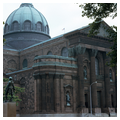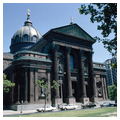It is a tribute to the ingenuity of the planners of the Benjamin Franklin Parkway (
PH116) that they so deftly incorporated the parkway's principal mid-nineteenth-century monument, this Roman Catholic cathedral. The monumental Roman Baroque scheme with its great copper-clad dome was begun just after the Know-Nothing Riots of 1844, which destroyed a number of Catholic institutions (
PH10), and its site and size denote the combative and assertive Church in a period of crisis. The original plan by LeBrun, with its massive vaulted nave and crypto-collateral side aisles, was based on Rome's sixteenth-century Church of the Gesu. By 1851, perhaps disappointed in the slow progress of the project, the bishop replaced LeBrun with John Notman, under whose direction the facade was constructed. Conflicts over prices brought LeBrun back in 1860 to complete the upper levels. It was the Catholic LeBrun who supervised the Baroque splendor of the interior that links the church visually to Rome. The decoration is by Constantino Brumidi, decorator of the U.S. Capitol rotunda. The interior with its spectacular Romanlike barrel-vaulted
You are here
Cathedral of Sts. Peter and Paul
1846–1864, Napoleon LeBrun; 1851–1859, John Notman. N. 18th St. and Benjamin Franklin Pkwy.
If SAH Archipedia has been useful to you, please consider supporting it.
SAH Archipedia tells the story of the United States through its buildings, landscapes, and cities. This freely available resource empowers the public with authoritative knowledge that deepens their understanding and appreciation of the built environment. But the Society of Architectural Historians, which created SAH Archipedia with University of Virginia Press, needs your support to maintain the high-caliber research, writing, photography, cartography, editing, design, and programming that make SAH Archipedia a trusted online resource available to all who value the history of place, heritage tourism, and learning.





